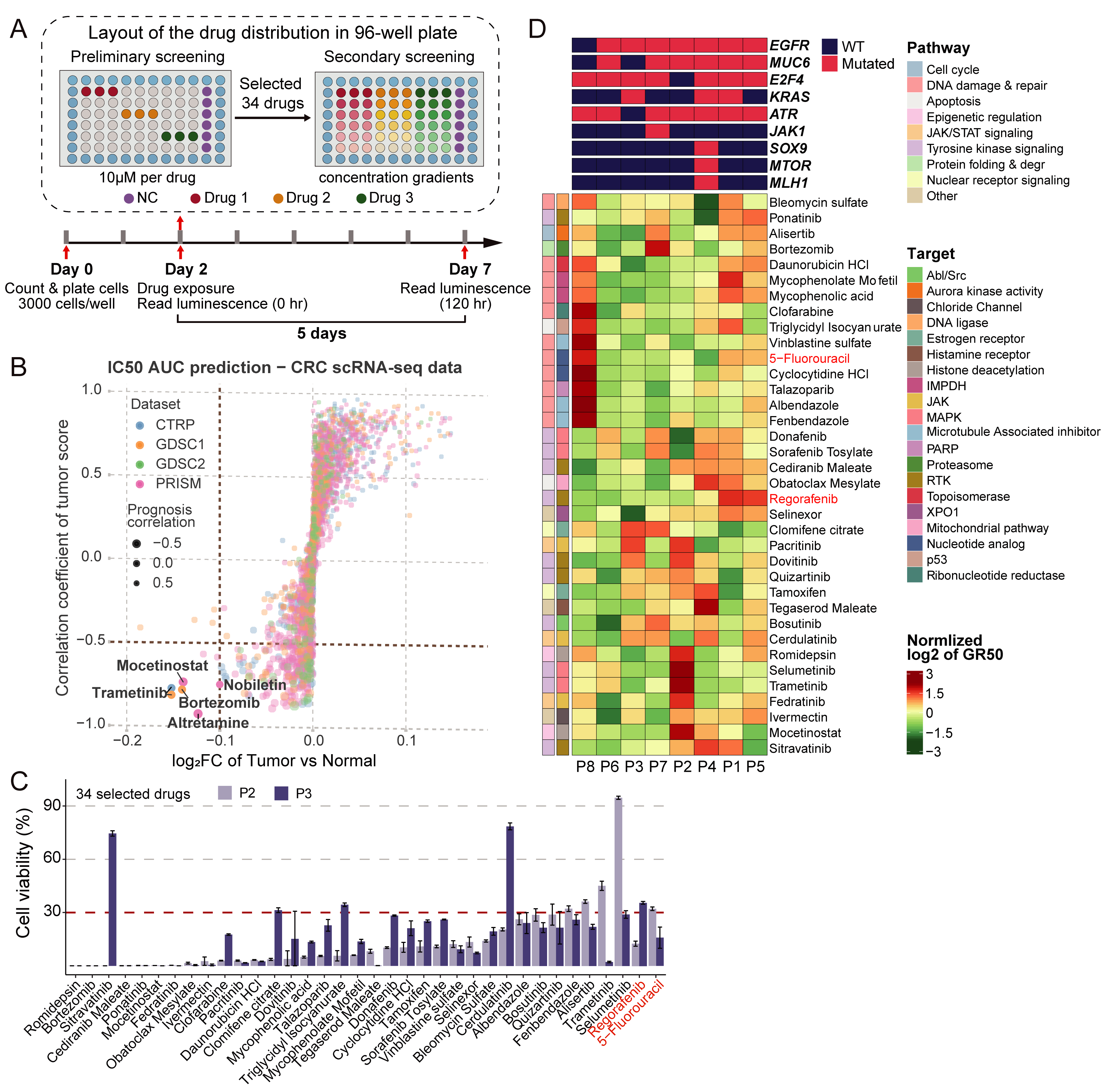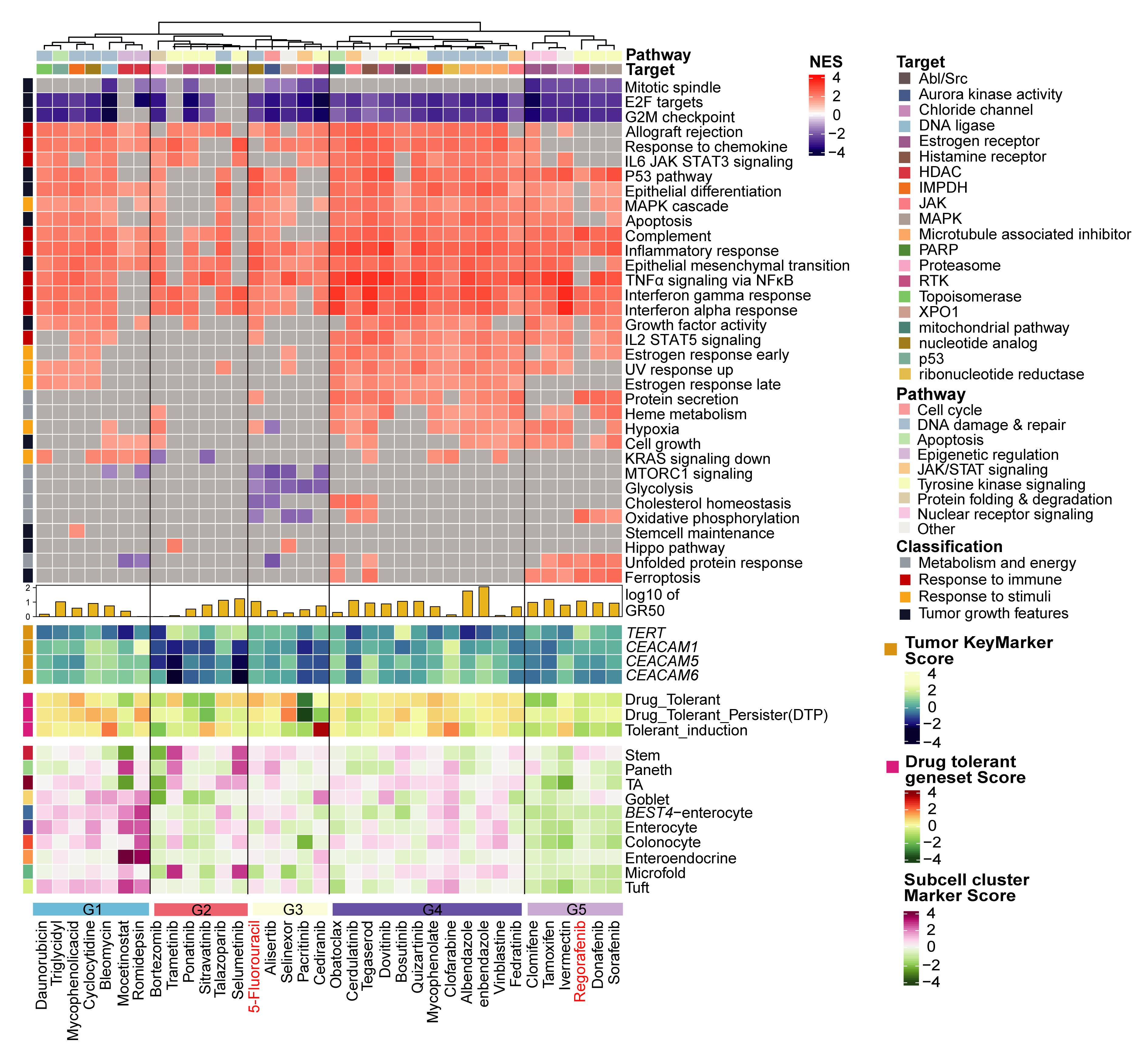
Protein & Cell | Drug repurposing screening and mechanism analysis based on human colorectal cancer organoids
Tumor organoid as the important model in vitro provides the new tool for tumor drug researches. Compared with the classical 2D-cultured tumor cell line system, 3D-cultured organoid can maintain tumor signatures of cancer patients well and reveal intra-tumor heterogeneity. Therefore, drug screening based on tumor organoids can not only identify new tumor drugs, but also explore drug sensitivity among different drugs. Although drug researches based on tumor organoids benefit to targeted-drug researches, the current evaluation criteria are mainly based on phenotype features such as cell proliferation and cell death. There is lack of detailed molecular analysis about drug functions.

Tang lab from Biomedical Pioneering Innovation Center (BIOPIC), Beijing Advanced Innovation Center for Genomics (ICG) collaborating with Wei Fu’s team from Peking University Third Hospital, constructed the in vitro drug screening and evaluating system based on human colorectal cancer (CRC) organoids. This research used the drug repurposing method, performed the drug screening of small-molecule drugs in vitro and verified results through the patient-derived organoid-based mouse xenograft (PDOX) system. Potential drugs for CRC were identified, and related mechanisms of potential drugs were analyzed in details at the transcriptome level. This research is published online with the title “Drug repurposing screening and mechanism analysis based on human colorectal cancer organoids” in Protein & Cell at June 22, 2023. The main results of this research are following:
1. Firstly, this study performed drug screening combining with drug prediction, and screened out 34 potential drugs targeting CRC from 335 FDA-approved clinical drugs for the treatment of other diseases. Before drug screening, the molecular characteristics of CRC organoids were evaluated at the multi-omics level including genome, transcriptome and methylome, and the consistency between tumor organoids and tumors in vivo was verified. It is worth mentioning that KRAS mutation happened in 3 out of 8 CRC organoids constructed in this study, which is one of the most common mutations in CRC. The CRC organoids in this study included both types with KRAS mutations and without KRAS mutations, which are representative and can better reflect the tumor characteristics of various subtypes of CRC. As for drug screening, the FDA-approved drugs for treating other diseases were used in order to avoid toxic side effects. Besides, the existing drug databases were also used for drug prediction. 5-fluorouracil and regorafenib, which are commonly used in cancer treatment, were used as positive controls. The screening results showed that among the 335 drugs including predicted drugs, 34 drugs had the potential to kill tumor cells of CRC organoids. In order to further confirm the killing effects of the screened 34 drugs on CRC organoids from different patients, the study tested the drug effects in 8 CRC organoid lines. The results found that the sensitivities of organoids from different patients responding to 34 candidate drugs as well as 5-fluorouracil and regorafenib were different. The differences indicated that the drug responses vary greatly between different patients, which shows the importance of screening drugs to guide patients' clinical treatments by using organoids.

2. Secondly, by taking advantage of RNA-seq, this study described the biological mechanisms of drugs and classified the drug response patterns of CRC organoids into 5 prevalent and representative groups, which represent the general responding features of CRC to different drugs. In an attempt to decipher the modes of action (MOA) of drug candidates that potentially inhibit CRC, we performed RNA-seq for organoids treated with all these 34 drug candidates. Gene set enrichment analysis (GSRA) was used to explore the expression of tumor-related pathways such as cell proliferation, immune activation, stress and metabolism in organoids after drug treatment. It was found that although the screened drugs can inhibit the cell viability of tumor organoids at the transcriptome level, the cell signaling pathways interfered by different drugs are different, indicating that different drugs have different MOA. The responses can be mainly clustered into 5 groups. Pattern 1 (G1) was annotated as a differentiation induction group, which is characterized by higher expression of marker genes for different intestinal epithelial cell types. Compounds in Pattern 2 (G2) significantly repressed the growth factor responses and the regulation of MAPK signaling pathways, which is identified as a growth inhibition group. Pattern 3 (G3) was identified as the metabolism inhibition group. Drugs in this cluster inhibited the expression of metabolism-related pathways of CRC organoids, particularly the glycolytic pathway. Pattern 4 (G4) exhibited an interesting signature that the immune response- and stress response-related pathways were activated. Pattern 5 (G5) was identified as the cell cycle inhibition group, which revealed the strongest phenotype displaying a decline in the cell cycle and DNA replication. It is worth mentioning that G2, G3 and G5 were considered to be the common functions of drugs to kill tumor cells in the previous tumor drug screening researches, and G1 and G4 have other tumor-killing effects in addition to classical effects. Related in vivo experiments and clinical trials need to be further carried out to prove their multi-level effects on tumor cells.

3. Thirdly, to assess the performance of the drugs in the in vivo environments, PDOX models were successfully established and proved the potential values of Trametinib, Bortezomib and Fedratinib to treat CRC. By taking into consideration of the GR50 information and clinical toxicity of the drugs, one or two drugs with low GR50 values and low toxicity in clinical use were selected out from each drug response group (7 drugs in total) for tumor suppression experiments on PDOX. Besides, 5fu was used as a positive control. By counting the tumor weight in mice after drug treatment, this study found that the median tumor masses were reduced after treatment with all of these eight drugs, indicating that consistent with the results of in vitro screening experiments, all the drugs we screened had potential tumor-suppressive effects. In addition to the commonly used clinical drug (5-fluorouracil, 44% reduction, p-value = 0.032), trametinib (41% reduction, p-value = 0.023), fedratinib (42% reduction, p-value = 0.033) also showed significant reduction in the tumor weight compared to the controls. Furthermore, this study validated the tumor-suppression effects of the drugs at the transcriptome level. This study dissected the tumors in mice after drug treatment and conducted RNA-seq. Trametinib, bortezomib and fedratinib led to a significant downregulation of cell cycle-related pathway genes.

In summary, this study conducted robust organoid-based drug screening, profiled drug responding signatures of CRC organoids, identified potential repurposed drugs, and assessed the in vitro and in vivo drug screening system based on transcriptome features, which provided a sequencing-based drug identification strategy that will accelerate the development of clinical trials of CRC.
Dr. Yunuo Mao from Peking University, Ph.D. candidate Wei Wang from Peking University and Dr. Jingwei Yang from Peking University are the co-first authors of the paper. Professor Fuchou Tang from Beijing Advanced Innovation Center for Genomics and Peking University and Professor Fu Wei from Department of General Surgery, Peking University Third Hospital are corresponding authors. This research project was supported by the National Natural Science Foundation of China and the Beijing Advanced Innovation Center for Genomics.
Link: https://academic.oup.com/proteincell/advance-article/doi/10.1093/procel/pwad038/7204964